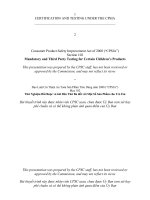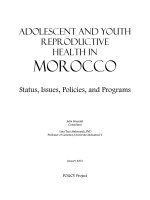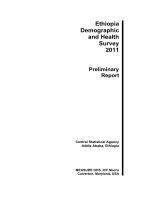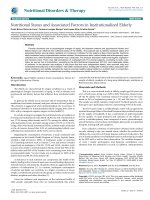PREBIOTICS, PROBIOTICS and SYNBIOTICS NEW OR OLD CONCEPT? doc
Bạn đang xem bản rút gọn của tài liệu. Xem và tải ngay bản đầy đủ của tài liệu tại đây (76.4 KB, 13 trang )
PREBIOTICS, PROBIOTICS and SYNBIOTICS
NEW OR OLD CONCEPT?
Although the concept of prebiotics and probiotics started in the
1970’s, it was dormant until 1994 when Danone, an European dairy and
confectionary manufacturer, launched Actimel probiotic drinking yogurt in
100 ml daily-dose bottles. Actimel revolutionizes the dietary supplements
market and is now considered as the leading “immunity” yogurt brand
worldwide. Actimel earned over $1.8 billion in retail sales in 2007. The
concept of prebiotics and probiotics reached its peak in April 2008 when the
International Probiotics Association had its World Congress in Los Angeles,
CA. It was the first global prebiotics and probiotics event attended by
industry, academia and health care representatives. A world congress on
nutrients that were ignored or unheard of just 10 years ago.
Worldwide, prebiotics, probiotics and synbiotics are gaining
popularity and their claimed beneficial health effects are now accepted and
trusted by the general population. Daily intake of these supplements (i.e.,
drinking yogurt) is now fashionable among affluent families and young
generation. Consequently, these dietary supplements are now deliberately
added to many products with claims attesting to their health benefits. So, is
daily supplementation with prebiotics, probiotics or synbiotics a truly new
and innovative concept?
Definition of prebiotics, probiotics and synbiotics
Probiotics are living microorganisms, which, when ingested or
locally applied in sufficient numbers, provide the consumer with one or
more proven health benefits. The probiotic strains most commonly used are
Lactobacillus sp. (e.g., rhamnosus, acidophilus, casei, plantarum, reuteri,
etc.), Bacillus breve, Bifidobacteria sp. (e.g., lactis, longum, etc.),
lactococcus lactis and Propionibacterium freudenreichii.
The term “prebiotic” was coined by Gibson and Roberfroid in 1995
to describe ingredients that can boost the growth of beneficial bacteria
(probiotics) in the gastrointestinal (GI) tract. Prebiotics are derived from
insoluble fibers and oligosaccharides and include inulin (beta (2,1) linear
fructans), xylooligosaccharides, lactulose, galactooligosaccharides and
fructooligosaccharides. Prebiotics are thus non-digestible food ingredients
that, when consumed in sufficient amounts, selectively stimulate the growth
and/or activity of one or a limited number of bacteria in the GI tract resulting
in documented health benefits. The most well known prebiotic is inulin,
which is the major polysaccharide in many subsurface tubers and bulbs like
onions and agave. Agave is a plant in Arizona and is used extensively in the
production of tequila (a Mexican hard liquor).
Synbiotic is a mixture of pro- and prebiotics, which beneficially
affects the host by providing the survival and implantation of selected live
microorganisms in the GI tract. The market for prebiotics, probiotics or
“healthy” bacteria and synbiotics continues to grow as awareness of their
health benefits increases. Nowadays, even some manufacturers are
promoting the prebiotic effects as more useful than the probiotic bacteria
that they feed.
Claimed Health Benefits - Prebiotics
Claimed benefits of prebiotics include improved health and immunity,
reduced formation of potentially toxic or carcinogenic compounds (De
Preter et al., 2008), enhanced survival and reduced infections. The potential
of inulin to support bone health and prevent osteoporosis, which affects over
70 millions people in the US, Europe and Japan, is gaining popularity.
Currently, two approaches are being pursued to prevent osteoporosis. The
first approach is to optimize bone mass acquisition during adolescence and
the second approach is to minimize bone loss after menopause. The prebiotic
inulin works through the first approach by increasing colonic calcium
absorption during adolescence. In a study with human adolescents,
supplementation with a mixture of oligofructose and inulin is reported to
result in a higher absorption of calcium (38%) than the placebo group (32%)
(Abrams, 2005). The second approach is that of medications used for the
prevention and/or treatment of osteoporosis (e.g., Fosamax, Boniva, Evita,
etc.). These medications target the dynamic nature of bones by reducing the
rate of bone breakdown or loss. By reducing bone loss, bones can
accumulate bone minerals and increase bone density.
Researchers from Baylor College of Medicine recently discussed their
findings in the Journal of Pediatrics, indicating that a daily supplement of
prebiotics inulin and oligofructose may help adolescents maintain an
appropriate body weight and body mass index (BMI) during pubertal
growth. BMI normally increases during puberty and adolescents
supplemented with prebiotics for one year had a normal BMI of 0.7 kg per
m2 compared to the control group with a BMI of 1.2 kg per m2. The
researchers postulated that inulin and oligofructose may regulate appetite by
increasing GI peptides that modulate satiety such as glucagon-like peptide-
1(GLP-1) and concluded that prebiotics may prevent excessive teenage
weight gain.
The potential benefits of prebiotics for infant health have also gained
increasing acceptance by parents. Infants fed formula contained prebiotics
had a 6.5% lower incidence of recurring respiratory infections than placebo-
fed infants, according to a report by European researchers (Arslanoglu et al.,
2007). The authors indicated that while the exact mechanism of action is not
known, the immune modulating effect of the prebiotics via modification of
the intestinal flora was the likely reason. The study adds to an ever-growing
body of research reporting benefits of the inclusion of prebiotics in infant
formula.
As we age, the microbial flora of the intestinal tract changes with
decreases in levels of the beneficial bifidobacteria and increases in
potentially harmful clostridia, streptococci and enterobacteria. The shift in
the intestinal flora may be the etiology of constipation, colitis, irritable
bowel disease, or colon cancer in the elderly. Prebiotics can normalize the
intestinal flora as substantiated by studies conducted at Providence
University in Taiwan (Chung et al., 2008). The study consisted of elderly
subjects (average age of 78.6) who were fed either a daily supplement of
xylooligosaccharides (prebiotics from bamboo) or sucrose (placebo control).
At the end of the 4-week study, the population of the beneficial
bifidobacteria in the supplementation group was increased by 35% while no
increases were noted in the placebo control group. Since bifidobacteria
species seem to play a key role in the digestive and natural immune
functions of the GI tract, the beneficial alterations on bifidobacteria
population induced by prebiotics do contribute to the overall health and
well-being of elderly people.
Claimed Health Benefits – Probiotics and Synbiotics
Probiotic strains can be applied to a number of dairy products such as
yogurt, cream cheese, buttermilk, ice cream and fruit juices. Foods
containing probiotics are almost exclusively refrigerated products since
probiotics are destroyed by heat and other processing conditions. Claimed
benefits of probiotics include immune stimulation, enhancement of bowel
mobility, reduction of inflammatory or allergic reactions. Apparently a
combination of different probiotic strains is more effective than single
strains in reducing the ability of potentially pathogenic bacteria to colonize
the GI tract (Collado et al., 2007). The beneficial effects on the GI tract are
related to the capability of the probiotic bacteria to adhere to the GI walls
and, hence, displace the pathogenic enterobacteria.
In a study published in an open-access journal, Pant and co-workers
(2007) demonstrated that supplements of Lactobacillus rhamnosus GG
probiotic bacteria are effective against GI infection and diarrhea in infants.
Probiotics administered prior to infection with rotavirus can even prevent
rotaviral diarrhea. The proposed mechanism of action is the ability of
probiotics to cause stabilization of the mucosal barrier, production of anti-
microbial compounds and stimulation of the mucosal immune response
leading to an increase in secretory immunoglobulin A.
Researchers at the University College London conducted a
randomized clinical study with people diagnosed with alcoholic cirrhosis.
The probiotic Lactobacillus casei Shirota was given as a supplement for four
weeks. The authors reported that probiotics can restore the immune function
of neutrophils thus offering benefits for alcoholic livers (Stadlbauer et al.,
2008).
The ability of the probiotic Lactobacillus salivarius to neutralize
Listeria monocytogenes, an often-lethal pathogen in pregnant women is
related to the probiotic secretion of an antibiotic-like compound (Corr et al.,
2007).
Synbiotics have been shown to provide multiple advantages such as to
reduce symptoms of childhood eczema (atopic dermatitis) and other allergic
reactions in infants. According to the American Academy of Dermatologists,
eczema affects between 10 to 20% of all infants, but almost half of these
infants will be free of symptoms between the ages of 5 and 15.
The incidence of colorectal cancer is rising and it is suggested that
80% of colorectal cancers may be preventable by dietary changes. In fact,
daily intake of synbiotics can significantly decrease beta-glucuronidase
activity, an enzyme produced by pathogenic bacteria in the GI tract (De
Preter et al., 2008). Inhibition of bacterial beta-glucuronidase is valuable in
the prevention of colon diseases. It has been shown that administration of
synbiotics can reduce colon cancer markers and colonies of Clostridium
perfringens, a strain reported to possess the metabolic capacity converting
non harmful dietary ingredients into carcinogenic molecules.
Regulatory Status
The market for prebiotics, probiotics and synbiotics will continue to
grow and from a regulatory standpoint what claims can be made for those
products?
In the US, these products could be regulated as dietary supplements,
GRAS (Generally Recognized As Safe) ingredients, food additives, or drugs
depending how the product is claimed. In general, beneficial health claims
can be divided into nutritional claims, structural/functional claims and
treatment claims, and each type of claims has its own burden of sufficient
scientific evidence and substantiation.
Most of the products already on the market are labeled with
structural/functional claims, which describe the role of the nutrient or
ingredient intended to affect normal structure of functions of the human
body. Structural/functional claims do not require pre-market approval and
authorization by the Food and Drug Administration (FDA), which means
that the “burden of proof” rests with the manufacturers and not the FDA. As
structural/functional claim, the manufacturers can label these products as (a)
to support immune function, (b) to support healthy intestinal balance, (c) to
promote immune system and overall health, (d) to fortify body natural
defenses or (e) to maintain a healthy GI tract. Since the claim is not
approved and/or regulated by FDA, effectiveness of some products remains
doubtful.
A search of the FDA data base reveals that there are no approved
treatment claims for prebiotics, probiotics or synbiotics. Treatment claims
refer to the diagnosis, treatment, mitigation or prevention of a disease,
disorder or abnormal physical state or symptoms.
Beneficial health claim is not without risk and liability. Indeed, in
January 2008 a class action was filed against the company Dannon, accusing
it of fraudulent health claims to sell some of its Activia and DanActive
yogurt brands. The lawsuit alleges that Dannon does not possess “clinically
and scientifically” proven data to claim beneficial health effects.
New or Old Concept?
Archeological discoveries prove that early humans knew and included
prebiotics in their diet as a caloric source. Subsurface tubers, rhizomes and
perennial bulbs, many rich in prebiotics, were important sources of energy in
prehistoric staples. Inulin, the major indigestible polysaccharide in many
subsurface tubers and bulbs like onions and agave, dominated the dietary
intake of humans hundreds of thousands of years ago. In fact, archeological
records showed residues of inulin-rich plants in pits used as earth ovens. By
cooking the agave and other inulin-rich plants in earth ovens, where
temperatures were less than 100o Celsius, the loss of inulin from the cooking
process was minimized.
Finally,
To entice the health-conscious individuals, nutritionists claim that
most consumers’ diets are fiber deficient. In response to this, the market for
fiber-enriched foods and beverages and prebiotics has steadily grown. Then
with obesity on the rise worldwide and the increased incidence of diabetes at
all ages, weight-conscious consumers are seeking food products with less
calories, reduced sugar, less fat and at the same time providing health and
performance benefits. No wonder why probiotics and synbiotics are in great
demand. So, is it a new and innovative concept? Perhaps only true to
Westerners!
For Vietnamese people, we are all aware of “dưa chua”, this
fermented product dating back to who knows when. Jars of the fermented
green mustard are a familiar sight in every Vietnamese’s kitchen and the
proud displays of the Vietnamese ladies. “Dưa chua”, a milestone of “công
dung ngôn hạnh”! “Dưa chua”, a synbiotic mixture of healthy probiotic
bacteria and prebiotic fibers in a slightly pungent, sweet and sour aqueous
medium! Our mothers and sisters have known for years the benefits of
probiotics (albeit cannot explain it) that to make excellent crunchy “dưa
chua”, don’t use distilled or sterilized water but one must re-use the “nước
dưa” from the previous batch. Traditionally, “nước ao” yields the tastiest
“dưa chua”. That’s ingenious, that’s recycle and that’s sustainability! We
don’t need to be told that prebiotics can prevent weight gain. Ask any
Vietnamese female teenager, she will tell you how to lose weight with a diet
based on “nước dưa chua”. “Dưa chua” is also our culture since there is no
“Tết” without the traditional “thịt mỡ dưa hành câu đối đỏ” and “dưa chua”
undoubtedly enriches our culinary repertoire with dishes like “thịt đông dưa
chua”, “canh dưa chua nấu sườn” and “dưa chua xào thịt bò”.
Our fathers don’t care whether bamboo contains xylooligosaccharides
but they do appreciate “vịt xáo măng” and they do recognize the delicious
and healthy effects of “măng”. We are also experts in probiotics. Look at the
Vietnamese “ya ua”. I must honestly attest that no brands of yogurt can
surpass our Vietnamese “ya-ua made with condensed milk” sold in
transparent plastic cups.
Therefore, the concept of prebiotics, probiotics and synbiotics is “old
news” to us, proud Vietnamese people with a long 4000-year period of
heritage and culture. Finally, for your daily requirement of pre-, pro- and
synbiotics, I would highly recommend a bowl of “cơm nguội, nước dưa chua
với tôm kho”.









